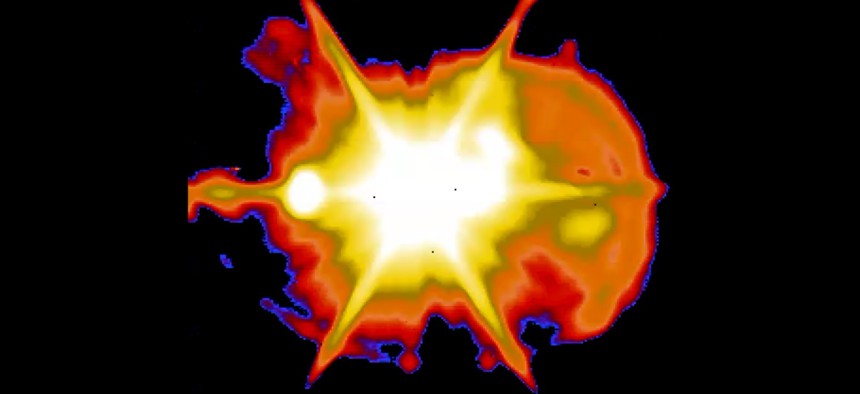
The Missile Defense Agency (MDA) and U.S. Navy sailors manning the Aegis Ashore Missile Defense Test Complex (AAMDTC) at the Pacific Missile Range Facility (PMRF) at Kauai, Hawaii, successfully conducted Flight Test Integrated-03 (FTI-03) MDA
Trump’s New Missile Policy Relies Heavily on Largely Unproven Technologies
New adversary missiles are to be met by a host of technologies that, by and large, don’t exist yet.
President Donald Trump took to a Pentagon podium on Thursday to paint a picture of a gathering storm — a not-too-distant storm of long-range, defense-evading enemy missiles.
“All over, foreign adversaries, competitors, and rogue regimes are steadily enhancing their missile arsenals...Their arsenals are getting bigger and stronger,” Trump said. “They're increasing their lethal strike capabilities, and they're focused on developing long-range missiles that could reach targets within the United States.”
It’s a real problem. Arms watchers have observed China, Russia, and North Korea rapidly developing new missile capabilities. The Trump administration’s newly unveiled policy solution to this problem, embodied in the Missile Defense Review released Thursday, is a crash effort to develop tech and hardware solutions that are either less than perfect or so new and experimental as to be almost speculative.
The new missile-defense strategy has two main emphases that separate it from its predecessor, laid out in the 2010 Ballistic Missile Defense Review. The first is on defending the American homeland; the second is on defeating hypersonic and other kinds of new and emerging types of missiles.
Ever since ICBMs were first aimed at the United States, the chief defense has been deterrence: the threat of a retaliatory nuclear strike. In the past decades, however, the United States has spent billions of dollars to develop and deploy systems designed to bring down a handful of incoming ICBMs. The Ground Based Midcourse Defense system currently includes 44 anti-missile missiles, or interceptors, in Alaskan and Californian silos; plans call for adding 20 more in Alaska and a study of a new interceptor site on the East Coast.
The GMD interceptors work like a bullet hitting a bullet, striking the incoming missile near the apogee of its journey to its target. But there’s a big problem: their performance is only so-so. Former Missile Defense Agency director Trey Obering once described the odds of a successful GMD intercept as a coin toss. Between 1999 and 2017, MDA’s record was nine hits in 18 attempts. Last May, a Government Accountability Office report noted uneven progress bringing up the success rate. Bottom line, you would need two fire two interceptors to have a good chance of bringing down the missile.
And even if a GMD interceptor could be relied upon to hit a missile every time, the entire fleet is only roughly equal to China’s ICBM force and far, far smaller than Russia’s.
To improve the odds of downing enemy missiles, the Pentagon has been looking for ways to hit them when they’re just taking off — or even when they’re still on the launch pad or mobile launching truck — before they pick up speed, gain maneuverability, shoot off decoys, and deploy multiple reentry warheads. The first challenge is spotting the heat generated by the rocket engine. The United States has a wide constellation of satellites to do just that, and is adding more in a new “sensor layer.” But once you detect the launch, you have seconds to hit the ascending missile. You have to almost be right on top it. That’s incredibly hard to do.
One system intended to do it is the SM-3 IIA interceptor missiles being deployed aboard Navy destroyers and some on land. MDA Director Lt. Gen. Samuel Greaves said on Thursday that said he has “extremely high confidence” in them. But they have performed unevenly in tests against merely regional missiles; their performance against faster, higher, larger ICBMs remains unknown. It’s something that they will test, according to the Review.
But the new missile-defense strategy rests most of its hopes on other technologies that essentially do not exist, and may never do so. The review says, for example, that the F-35 Joint Strike Fighter could be networked with new sensors and outfitted with new missiles to take out adversary missiles on the launch pad. Tests have shown that the F-35 can do this. But the distance is the larger problem: the jet basically has to be in the enemy’s airspace already.
The notion of multiple F-35s loitering over China and Russia waiting to kneecap rockets during liftoff is a fantasy. That’s what scientists writing for the National Academy of Scientists found in 2012.
“Your range is going to be a function of the size of the booster and these things are pretty big,” said Jeffrey Lewis, the director of the East Asia Nonproliferation Program at the Middlebury Institute of International Studies at Monterey. “If you’re going to put one of these on an F-35—and just one is a kind of a waste—it’s going to have to be really small, which means you’re going to have to be really close. The universe of cases where you’re going to be so close you can intercept it, you could probably just blow it up before they launch it. It’s like a Goldilocks scenario.”
That expert skepticism came to light on Thursday when, as Pentagon officials were briefing the new missile review to reporters, one journalist asked if relying on fighter jets to shoot down boost phase missiles was so impractical as to be a non possibility.
“That’s not true,” said Michael Griffin, defense undersecretary for research and engineering. Officials went on to say that they would be looking at new, previously unseen missiles for future tests.
Another possible way to hit ascending missiles s with lasers mounted on satellites in low Earth orbit. In the review, Pentagon leaders declare that they will be studying taking a good look at the potential. This is one of the most controversial aspects of the policy, since it is, in essence, a declaration of an intent to weaponize space. Politics aside, as of right now, boost phase intercept is a good idea with little behind it.
The second thrust of the new strategy takes the U.S. into new, uncharted territory. It’s a direct response to Chinese and Russian efforts to field hypersonic long-range weapons that fly far less predictably than ICBMs, and thus defy traditional intercept. The Pentagon is trying to develop its own offensive hypersonic missiles, essentially the bringing the idea of mutually-assured destruction into the new century.
Finally, the review says that protecting U.S. territory gets easier if allies and partners help. In his remarks, Trump expressed a desire to remove bureaucratic hurdles that inhibiting the export of U.S. missiles. In fact, the review’s release was delayed by months,in part by considerations about how to strike the right tone with allies. It seems to acknowledge that the best defense for the U.S. homeland against missiles, particularly from Russia and China, begins with foreign partners who are deeply interested in joining your collective defense. That’s difficult to do while you’re alienating them.




